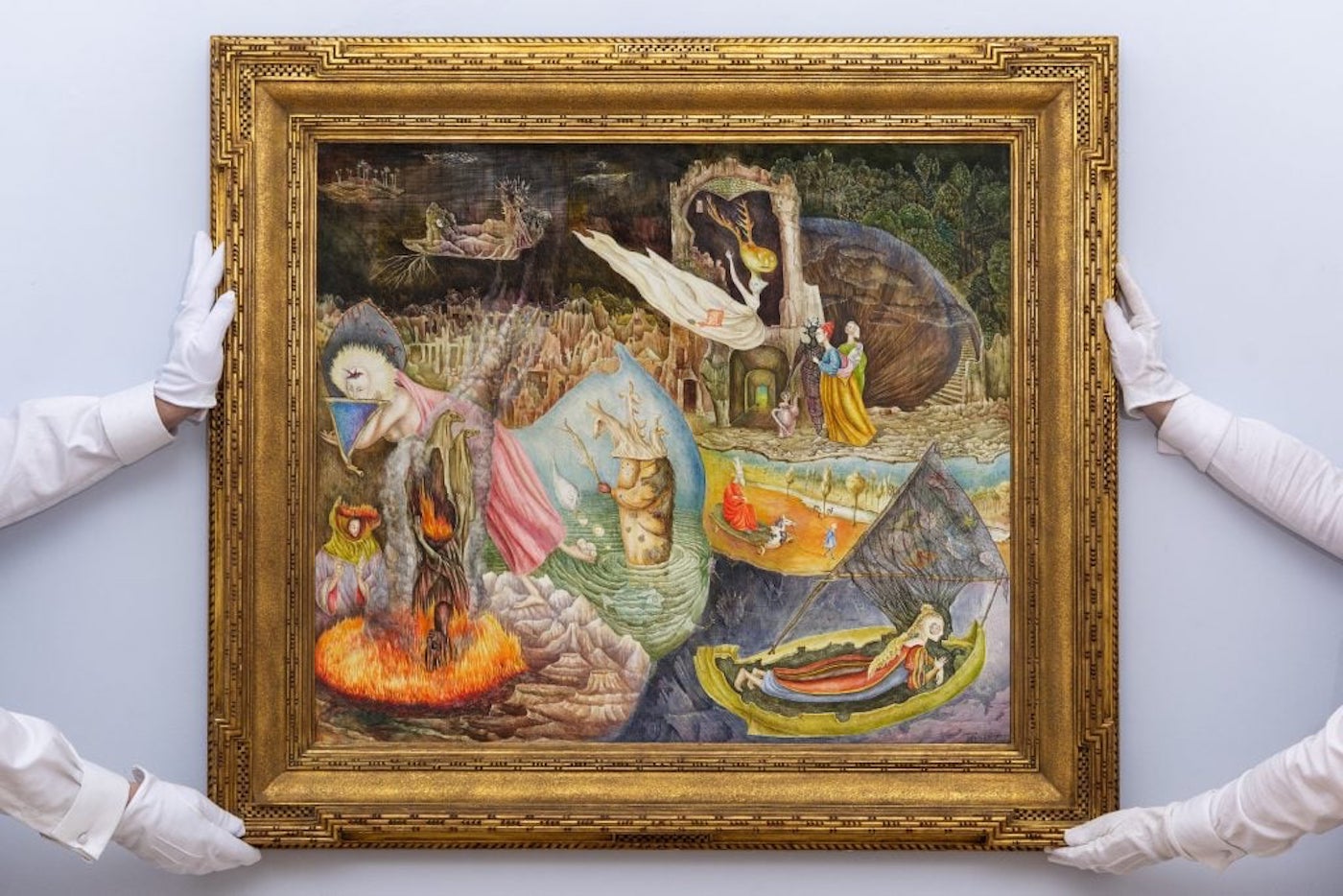Sotheby’s New York, Leonora Carrington’s 1945 tempera painting, Les Distractions de Dagobert, sold for a record-breaking $28.5 million (including fees), setting a new high for the British artist.
The captivating piece, estimated between $12 million and $18 million, became the highlight of Sotheby’s modern art evening sale. An irrevocable bid secured its sale, ensuring it would find a new owner.
The painting attracted intense bidding for ten minutes, featuring a dramatic contest between a room and phone bidder connected with Alejandra Rossetti, Sotheby’s Miami business development head. When the bid soared past $20.8 million, a third contender joined via Jen Hua, Sotheby’s deputy chairman for Asia and chairman for China. Ultimately, the decisive bid of $24.5 million from the room silenced the competition. Auctioneer Oliver Barker acknowledged the winning bidder’s patience before concluding the sale with his gavel.
The victorious bidder was Eduardo F. Costantini, the Argentinian developer and founder of the Museum of Latin American Art in Buenos Aires. “This is a superb piece in the history of Surrealism,” Costantini remarked. “I was the underbidder 30 years ago for this picture, and I didn’t want to miss it this time.”
Interestingly, Costantini was outbid for the same work in 1995, when it sold for $475,500 (approximately $990,000 today when adjusted for inflation).
The sale price of $28.5 million far surpassed Carrington’s previous auction record of $3.3 million, set at Sotheby’s two years ago.
Les Distractions de Dagobert is a mesmerizing depiction of a Boschian garden of earthly delights, reflecting the lavish life of Dagobert I, the famed 7th-century Frankish king. Carrington, who was 28 and expecting her first child then, infused the painting with intricate, surreal imagery and diverse vignettes.
Dealer Emmanuel Di Donna, who featured the painting in his 2019 exhibition “Surrealism in Mexico” at his Manhattan gallery, praised it as “one of her great paintings,” noting its complex and evocative imagery.
The painting showcases various hybrid creatures and enigmatic rituals, drawing from medieval European history, contemporary scientific literature, and Celtic and Mexican mythology. At its centre stands a king in a red robe, encircled by various fantastical visions, including a flying woman with a stag head and a man engulfed in flames.
Interest and prices for female Surrealists have been steadily climbing, with notable recent records for Frida Kahlo ($34.9 million in 2021) and Leonor Fini ($2.3 million in 2021).
Les Distractions de Dagobert has been requested for two major exhibitions in 2025: “Leonora Carrington: Dream Weaver” at the Rose Art Museum at Brandeis University and “Surrealism” at the Philadelphia Museum of Art
Leonora Carrington (1917-2011)
Leonora Carrington, born on April 6, 1917, in Clayton-le-Woods, Lancashire, England, emerged as one of the most captivating and influential artists and writers of the 20th century. A key figure in the Surrealist movement, her works are celebrated for their mystical themes and fantastical imagery.
Carrington was raised in a wealthy family, which afforded her an education in elite convent schools. However, her rebellious nature and artistic inclination soon led her to pursue formal art training at the Chelsea School of Art and later at the Ozenfant Academy of Fine Arts in London.
In 1937, Carrington met the German Surrealist artist Max Ernst. Their intense romantic and creative partnership greatly influenced her work. The couple moved to Paris, where Carrington became immersed in the Surrealist circle, befriending notable artists like André Breton and Salvador Dalí. Her early works, characterized by dreamlike scenarios and mythical creatures, began to garner attention.
World War II brought turmoil; Ernst was interned by the Nazis, and Carrington fled to Spain, experiencing a mental breakdown that led to her institutionalization. Her eventual escape to Mexico City in 1942 marked a significant turning point. She found a vibrant artistic community there and forged lifelong friendships with fellow artists Remedios Varo and Kati Horna.
Carrington’s time in Mexico profoundly shaped her art and writing. Her paintings often feature fantastical scenes influenced by Celtic mythology, Mexican culture, and alchemical symbols. Notable works include The House Opposite (1945) and The Giantess (The Guardian of the Egg) (1947). Her literary contributions, such as the novel The Hearing Trumpet (1976), further cemented her status as a pioneering figure in Surrealism.
Despite her global influence, Carrington remained somewhat of an enigma, living a relatively private life in Mexico City until her death on May 25, 2011.
Photo: Leonora Carrington, Les Distractions de Dagobert (1945). Courtesy Sotheby’s.

